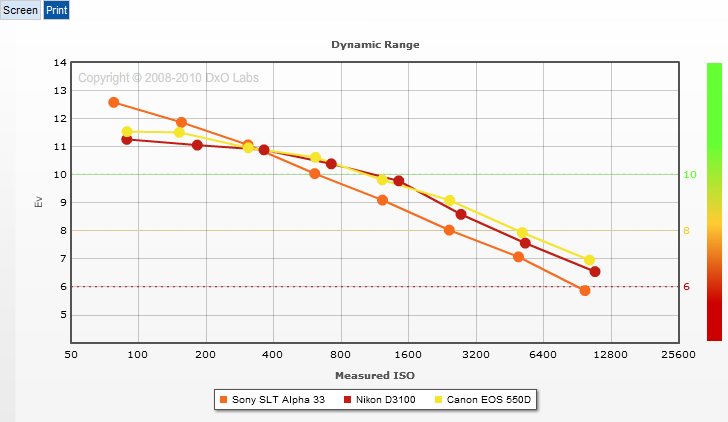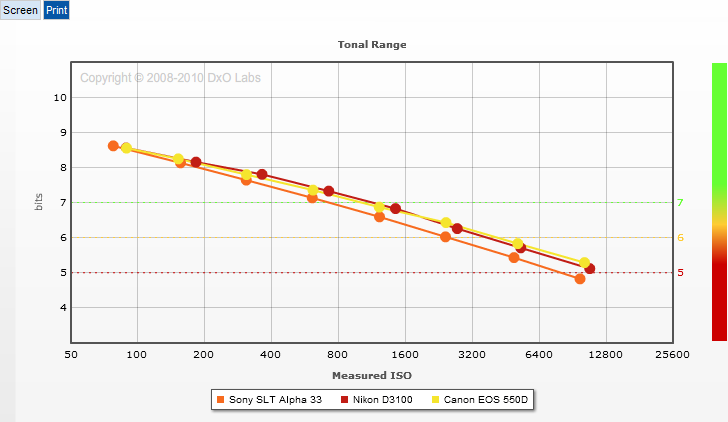|
Page 4 of 9
Dynamic Range
"Dynamic range or light sensitivity range of a sensor indicates the ratio of light exposure between the highest
brightness a camera can capture (saturation) and the lowest brightness it can effectively capture (typically when noise becomes more
important than signal, i.e., SNR < 0 dB). This range indicates the maximum contrast that can be effectively captured by the sensor.
The larger the dynamic range, the better, as the sensor is able to capture higher-contrast scenes. Note that dynamic range is expressed
on a logarithmic scale in EV (same as f-stop), thus an increase of 1EV corresponds to a doubling of dynamic range."
(DxO Labs)
Here's an analysis by our partner, the (DxO Lab):

Dynamic Range Chart (Screen and Print)***
While the dynamic range of almost 12 f-stops is excellent at low ISO, it decreases clearly recognizable by 2 f-stops in mid ISO range and drops below 8 f-stops at high ISO - not to mention values below ISO 3200. The overall dynamic range of the Sony Alpha SLT-A33 is good and at low ISO better than the Canon EOS 550D and the Nikon D3100. However, below ISO400 the page already turns and the Sony is about 1 f-stops below Canon and Nikon.
Possibly more interesting than the naked noise and dynamic range figures is the tonality which gives you a better idea of the visual effect of both aspects.
"Tonal range indicates how many gray levels are distinguishable up to noise in an image. The tonal range corresponds
to an integration of the signal-to-noise ratio (SNR) over the dynamic range of the sensor, and is therefore representative of the average
noise level. The larger the tonal range, the better the image: noise is lower, and subtle nuances can be distinguished. It is expressed
on a logarithmic scale as the bit depth necessary to encode that number of gray levels: an increase of 1 bit of tonal range corresponds
to doubling the number of distinguishable gray levels." (DxO Labs)

Tonal Range Chart (Screen and Print)***
Regarding the tonal range, the Sony Alpha SLT-A33 delivers up to eight bits of various brightness levels between pure black and absolute white at low ISO, which equates to a contrast ratio of 256:1. At mid and high ISO settings however the tonal range drops below 7 bits, which is in line to other cameras in this segment like the Canon EOS 550D and the Nikon D3100."
***The first "tab shows the measurement values and graph derived directly from a RAW image when displayed on a computer
screen at 100% magnification." The second tab display the print performance measurements and graph derived directly from a RAW image after
a normalization step that transforms all images, regardless of original resolution, to an 8 Mpix image. The print size we have chosen is a
standard 300dpi 8"x12" format, which corresponds to about the physical size of an 8Mpix image printed at 100% magnification."
(DxO Labs)
|